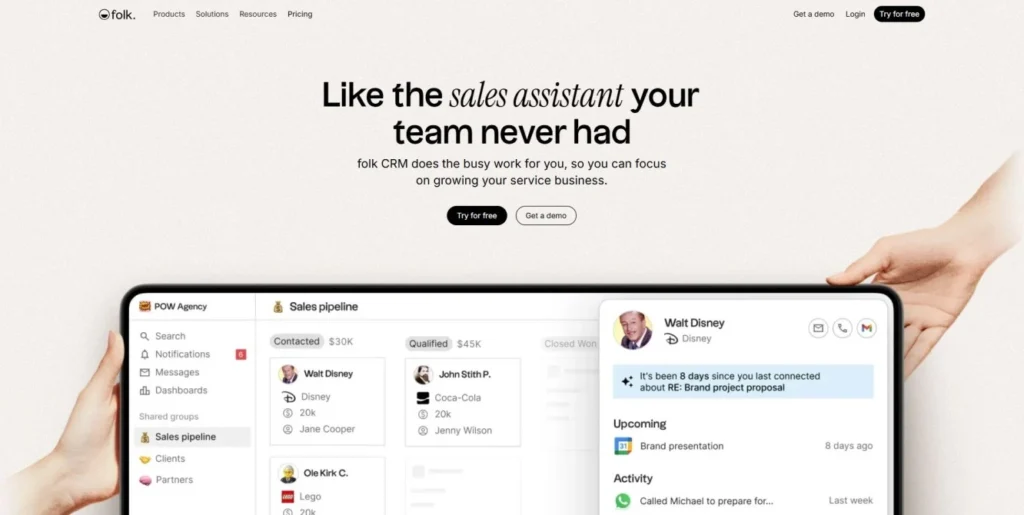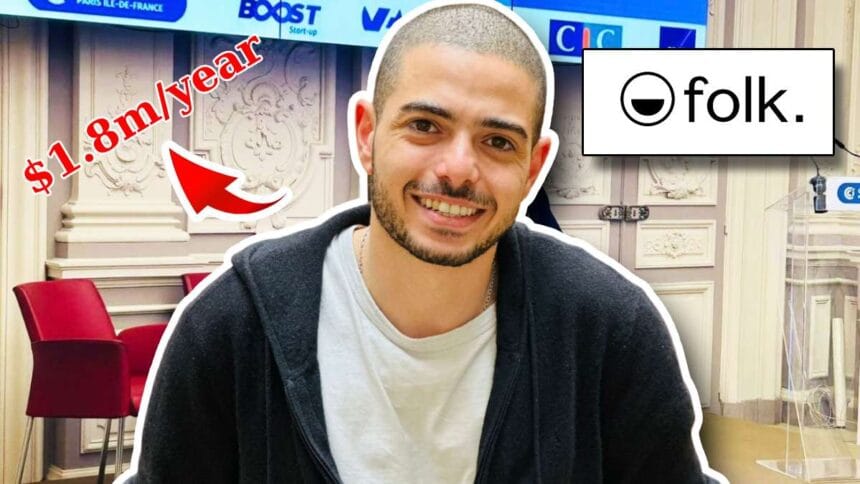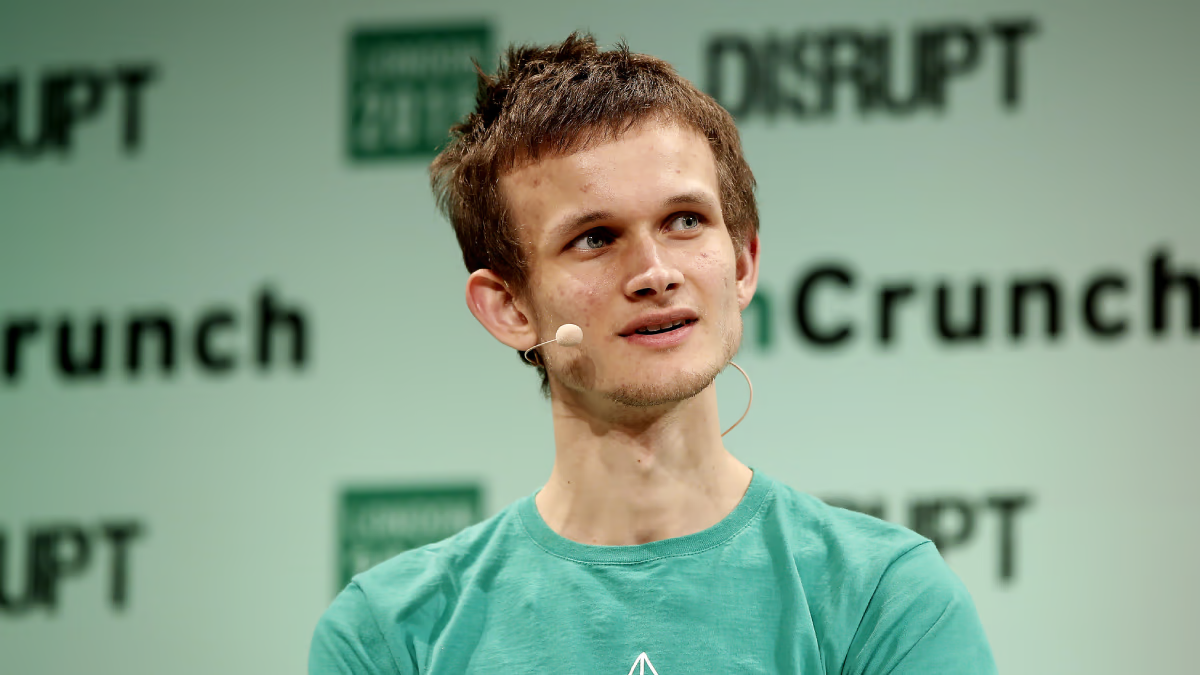In the competitive world of SaaS, Simo Lemhandez, the founder of Folk.app, has carved out a niche by revolutionizing the CRM space. With a background in consulting and a vision for simplicity, Simo has built a CRM tool that now generates $1.8M annually. Here’s how he did it.
Who is Simo Lemhandez and What is Folk.app?
Simo Lemhandez is a 29-year-old entrepreneur from Morocco. A graduate of HEC Paris, he has worked with prestigious firms like McKinsey and Morgan Stanley and was recognized in Forbes’ 30 Under 30 list.
Folk.app is a modern CRM (Customer Relationship Management) tool designed to simplify sales processes. Unlike traditional CRMs like Salesforce or Pipedrive, Folk.app is intuitive, collaborative, and seamlessly integrates with modern tools. Today, Folk app powers over 300,000 users and 3,000 clients worldwide, backed by $9M in funding from investors like Accel.
How Did the Idea for Folk.app Come About?
The Problem with Traditional CRMs
After leaving McKinsey, Simo attended Le Wagon, a coding bootcamp, and began freelancing. Managing leads across spreadsheets, LinkedIn, WhatsApp, and emails became overwhelming. He tried existing CRMs like HubSpot and Pipedrive but found them outdated, slow, and difficult to set up.
The Lightbulb Moment
Simo noticed a glaring contrast: the CRM market was massive, but user satisfaction was low. This sparked the idea for a modern, user-friendly CRM. He partnered with Thibaud Elziere, a seasoned SaaS entrepreneur, and Jean-Yves, a talented CTO, to bring the vision to life.
Validating the Idea
The team created a simple landing page to test the concept. The response was overwhelming—10,000 sign-ups confirmed there was a demand for a better CRM.
Building the Initial Version of Folk.app
Designing the Product
With $2.5M in pre-seed funding from Accel, the team began designing Folk app on Figma. They engaged with users from their waitlist, gathering feedback and iterating on the product.
Launching on Product Hunt
In April 2022, Folk.app launched on Product Hunt, earning “Product of the Day,” “Product of the Month,” and a nomination for “Product of the Year.” This launch marked the beginning of their public presence.
Monetizing the Product
By September 2022, Folk.app introduced a per-seat pricing model. This shift from manual Stripe payment links to an integrated payment system signaled the transition from a startup to a scalable business.

Launching Folk.app and Gaining Traction
Organic Growth
Folk.app’s initial traction came from organic efforts, including LinkedIn posts and word-of-mouth. The universal frustration with existing CRMs made the product a natural talking point.
Product Hunt Success
The team meticulously prepared for their Product Hunt launch, creating compelling assets and a high-quality demo video. The launch not only generated buzz but also established Folk.app as a serious contender in the CRM space.
Growth Strategy and Scaling Folk.app
Key Distribution Channels
Folk.app focused on three main channels for growth:
- Influencer Marketing: Partnering with micro-influencers on LinkedIn to amplify their reach.
- SEO: Optimizing their website to rank for CRM-related keywords.
- Affiliates: Collaborating with sales coaches and agencies to promote Folk.app to their audiences.
Metrics That Matter
The team prioritized CAC (Customer Acquisition Cost) payback, aiming for a 6-month payback period. By balancing organic and paid channels, they ensured sustainable growth.
Lessons Learned from Building Folk.app
1. The Importance of People
Simo emphasizes the value of surrounding yourself with the right team. Hiring enthusiastic, positive individuals and being decisive about letting go of mismatches has been crucial.
2. Funding Strategy
Folk.app chose a hybrid funding model—raising early to cover engineering costs and then focusing on profitability. This approach balanced growth with financial stability.
3. Market Selection
Choosing a large, established market like CRM allowed Folk.app to avoid the need for customer education. However, it also meant navigating intense competition.
Conclusion: The Journey of Building Folk.app
Simo Lemhandez’s journey with Folk.app is a testament to the power of solving real problems with innovative solutions. By focusing on user experience, leveraging organic growth, and making strategic investments, Folk.app has become a standout player in the CRM space. For aspiring entrepreneurs, Simo’s story highlights the importance of choosing the right market, building a strong team, and staying committed to your vision.
Frequently Asked Questions (FAQs)
1. What makes Folk.app different from other CRMs?
Folk.app stands out for its simplicity, modern design, and seamless integration with tools like LinkedIn, WhatsApp, and email. It’s designed to feel like a sales assistant rather than a cumbersome software.
2. How did Folk.app validate its idea?
The team created a landing page and gathered 10,000 sign-ups before building the product. This early validation confirmed the demand for a better CRM.
3. What was Folk.app’s growth strategy?
Folk.app focused on influencer marketing, SEO, and affiliate partnerships to scale. They prioritized CAC payback and balanced organic and paid channels.
4. How did Folk.app achieve its Product Hunt success?
The team prepared extensively for their Product Hunt launch, creating high-quality assets and a compelling demo video. This effort earned them multiple accolades and significant visibility.
5. What advice does Simo have for aspiring entrepreneurs?
Simo advises focusing on people, choosing the right funding model, and selecting a market with high growth potential. He also emphasizes the importance of enjoying the entrepreneurial journey.
Read Also: Vitalik Buterin Net Worth: Story Behind Ethereum’s Visionary




